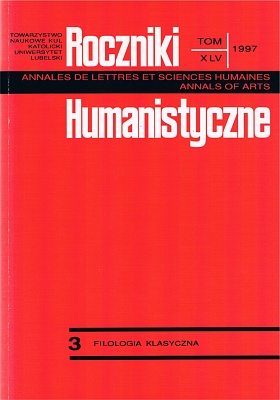Tertullian's Apologeticus. The Inventive Themes and the Composition of the Work
Abstract
The scheme of the persuasive expression outlined in this analysis is seeking to show what categories of demonstration Tertullian use when defending the case of Christianity. The study on Apologeticus, carried out within some aspects of rhetoric, is not sufficient for this kind of inspection. For they operate within such criteria, which do not follow from the constitutive elements of rhetorical argumentation, such as e.g. works which the problems of rhetorical character of the text and its consistence see in the species of speech. To explain the conception of the work the level was sought which is above the species sphere (in advance it does not exclude some species, nor its proper theme), and it allows to see various rhetorical means (e.g. figures or tropes) which shape and individualize the text. Such a level is the layer of argumentation, or argument. It is composed of that which makes that the premisses are assumed, namely the topoi.
As the analysis of the apology shows, the theme of knowledge as the capital moment of the work makes other plots dependent on it. Through various topoi it serves to justify all that stems from the belief in Christ and makes His advocates to face the then reality. Following the Greek apologists, Tertullian skillfully selects the topic which is supposed to give credence to Christianity. Within the framework of the plot of knowledge it realizes, first of all, the topos of word and deed, which allows to show Christians as almost perfect people. The same topos, but negated (thus, as it were, anti-words) explains why pagans are evil and hateful. The opposition: knowledge-ignorance makes it possible, thanks to the topos, to explain the falsity of pagan religion, and thanks to the proofs from the past and examples shows that the laws and customs of pagans should be renounced, or at least changed. By way of the antithesis the plot of knowledge is set in opposition to philosophy, thus a particular ignorance of pagans is manifested.
In as much as the inventive layer is to make hierarchy in the proof and give a general justification of the presented reasons, forming a common theme, the compositional level seeks to fragmentize the plot - distributing it with precision and dosing its tension. The compositional layer brings out that theme to the surface and allows us to find some clear relationships between the diversity of the thematic wholes. In this respect, Tertullian draws on to the antic patterns. The theme as a result of the application of various topoi and techniques undergoes amplification in those parts of the work which, according to the efficiency of persuasion, were supposed to be exposed. Thus it is with e.g. prooemium and epilogue, with preamunitio and recapitulatio, and also with those passages of oration which initiate new questions, summarize them or link them with others. Particular sequences of the compositional layer thus discipline extremely diversified theme and enhance the whole demonstration of the message.
Copyright (c) 1997 Roczniki Humanistyczne

This work is licensed under a Creative Commons Attribution-NonCommercial-NoDerivatives 4.0 International License.





